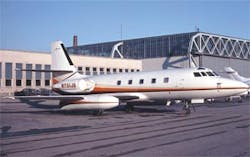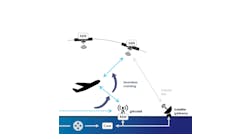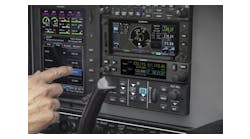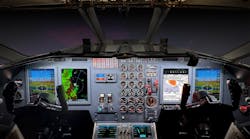The effects of aging on the human body often include degradation of the senses, aches and pains, restricted range of movement of limbs, the loss of control of various bodily functions, and of course the dreaded smell of old people. I still hear my mother telling me that I had better take care of myself now in order to hold off the onset of aging. In addition to lifestyle, environment can play a big role in longevity.
Many of us in the aviation maintenance field have had personal experiences with aircraft that appear to exhibit almost human-like personalities and, periodically, those that could be possessed. An old friend of mine had been hired on with a Fortune 500 company two weeks before they procured their brand new business jet. During visits to his hangar over the years, I routinely witnessed him talking to the aircraft while plying his trade and for 28 years the aircraft performed admirably. Two years after my friend retired the aircraft was sold as it had become problematic. Sounds like stuff for the twilight zone but most of it can be attributed to the cantankerous nature inherent with growing old. Like humans, the aging process can take its toll on aircraft and avionics systems.
Electrical Wiring Interconnect Systems (EWIS) has generated significant interest in recent years. So much so that Federal Air Regulation 25.1701 was created to ensure a well-defined method for achieving longevity in future aircraft designs, while the current challenge is to ensure safe and reliable operation today.
Most technicians are aware of initiatives sponsored by airworthiness authorities concerning aging aircraft issues. Many are structural in nature, dealing with the effects of fatigue and corrosion. Unfortunately it is often overlooked that the same two conditions can have serious impact on avionics.
Another detriment faced by many is acquisition of an older aircraft either through secondhand purchase or flight department mergers. In some cases, previous maintenance history may be all but unknown. A desirable (but not always practical) approach is to start at the nose and work back through the tail, looking for signs of areas that may require attention.
Radome
A radome is a very good example of a device that tends to mask defects. Unless a significant event such as impact damage occurs, it will remain in service while continuing to degrade. Today many of these protective fairings are fabricated using exotic materials such as quartz or a honeycomb composite, but in years past, fiberglass was the choice of many manufacturers. Transmissivity of the radome is its ability to allow radar energy to pass freely. In fact, current Class A radomes have a transmissivity of around 95 percent. This capability can be reduced by certain types of inappropriate repair or even excessive paint thickness.
Some styles of radome are also prone to erosion which can allow moisture to find its way inside the structure. Water will tend to absorb some of the radar energy. In severe cases may cause a significant reflection, resulting in a radar image constantly showing the aircraft in weather conditions.
Anti-erosion boots may be applied to the nose in an effort to reduce the effects of impact wear and may themselves be a cause of reducing transmissivity or can even cause electrostatic buildup. Electrical bonding is another concern with radomes, as most materials used in their construction tend not to be good conductors of electricity. As a result, specialized paint processes are often used to enhance conductive qualities and thickness of the combined coats have been found to reduce radar sensitivity. Static diverter strips are frequently applied to assist in the dissipation of electrostatic charges back to the airframe.
Condition of static strips, along with the appearance of their bonding point, can provide valuable information regarding their operational abilities.
Electrostatic bonding
The radome is not the only place where electrostatic bonding may be a problem. Most aircraft manufacturers make some provision within their prescribed maintenance programs for a resistance check of most external surfaces.
The tool of choice is usually the milliamp meter. Its use results in a frequently tedious process to verify adequate electrical connection between surface panels. Another way to validate electrical bonding is with a Corona Discharge Tester, which will enable the user to bring a highly charged device in close proximity to various aircraft surfaces and verify electrical current flow. Some operators have even built this quick and accurate means of testing into routine maintenance to ensure P-static-free operation.
Prior to using any high voltage devices, a visual inspection of the airframe is usually justified to detect any burn marks or discoloration that may indicate inadequacies in the airframe electrical current paths. The common use of composite panels may promote problematic trends in regard to static dissipation. Some manufacturers have used tin inserts in carbon panels to assist in allowing attaching screws to dissipate electrical charges. When anti-corrosive materials are applied to the screws it may reduce the quality of the electrical bond. On the other hand, if anti-corrosion protection is not applied, the dissimilar metal between steel screws and tin insets may result in electrolysis, again disturbing the path for dissipation of electrostatic buildup.
Once again, the repeated paint process over time may have removed or otherwise damaged protective coatings, resulting in poor static dissipation. There are the periodic (but hopefully infrequent) dents and dings that can occur to aircraft structure. Most technicians realize the implication that a creased skin panel could result in a crack, especially when pressurization cycles begin to accumulate. The same dent, even though minor, if directly in line with a static sensing port, can produce other ugly results even if the aircraft is not operating in Reduced Vertical Separation Minimums (RVSM).
Even paint deterioration can create problems. A small paint chip in just the right orientation to a static pressure port can cause altimeter errors or even autopilot stability problems. In some cases air data probes may have some type of metalized protective coating that can erode over time, resulting in static pressure reporting errors.
Pitot probes
Even pitot probes are subject to deterioration and can exhibit flaking of protective coatings within the reference port. Pitot tube alignment is another issue that should not be taken for granted. A small adjustment to probe angle may be associated with a bump against a toolbox. Someone in need of a handhold can result in a significant airspeed error — if severe enough, this may bring on an unexpected encounter with a stall situation. Angle of attack or stall vanes are also susceptible to the effects of aging. Often, cleaning solvents or paint strippers migrate into the housing that holds the bearings causing the unit to ratchet or bind. Heating elements will degrade with age and should be checked periodically to make sure they can provide adequate levels of ice protection.
Antennae
Externally mounted antennae are another area of concern on aging aircraft. It is not uncommon to see chips, cracks, and discoloration on various blade elements. In many cases sanding, filling, and painting are discouraged by component manufacturers as changes can occur to the antenna properties.
One typical problem area is the mating surface between the antenna base and the aircraft skin. Electrical bonding is usually a concern here and enhancements include conductive paste or gaskets impregnated with some form of wire mesh. Oftentimes the installation will bring several types of different metals in contact; with a small amount of moisture ingress, corrosion will begin to form. Even different types of sealants used around an antenna base to form a moisture barrier can contain corrosive agents or may not have conductive properties.
Similar concerns exist with static dischargers. Investigations to reveal approved and pertinent products are well justified when it comes to ongoing antenna maintenance. In some cases, the erosion preventive tape frequently found on the leading edge of an antenna can possess dielectric properties that may not be conducive to electrostatic dissipation.
When an antenna is attached to a primary airframe structure such as a pressure vessel, additional maintenance checks may be required for the fuselage opening and antenna attach points. Often Instructions for Continued Airworthiness (ICAs) are written into the aircraft maintenance program and may involve various levels of nondestructive testing to ensure structural integrity of not only the antenna attach points but the coax feed through as well.
Antenna cables are another casualty of the aging process. Over time insulation resistance may deteriorate, causing a change in cable capacitance and subsequent signal loss. Coax cables routed near a heat source such as bleed air ducting become even more susceptible. In addition, cable clamping or even bending can promote degradation. Excessive compression applied to a coax by a cable clamp or tie wrap can compress the dielectric core and alter the cable’s ability to conduct a signal. Once a coax is compromised, about the only good solution is cable replacement. It is highly desirable to conduct periodic testing of transmission lines. Testing can be accomplished rather easily using equipment such as a Time Domain Reflectometer (TDR) or even a meter to measure the Standing Wave Ratio (SWR). That is the actual transmitted wave relative to the energy returned.
Wiring
Interfacing new technology with existing aircraft systems can bring about challenges. Wiring is categorized based on function and certain circuits should be separated or segregated from certain other systems. An example: routing a power feed cable next to wiring for a system that may be susceptible to electro magnetic interference (EMI) is not recommended as the EMI from the feeder may corrupt the secondary system. FAR 25.1707 documents various areas of concern. In recent years, as a direct result of aging aircraft issues, manufacturers have been directed to include wiring practices and inspections in their continued airworthiness programs.
Trend monitoring is a common practice when it comes to tracking engine operations and scheduling maintenance events. Similar practices may be applied to avionics systems and should include communication radio power output checks, receiver sensitivity for communication and navigation radios, and even periodic corona discharge testing.
Good housekeeping practices are the best defense regarding the deterioration of aircraft. Metal shavings left to roost in a wire bundle will, in time, result in insulation failures and subsequent electrical arcing. Frequent wire bending will not only make the wire more susceptible to breakage but can also result in cracks in the protective coatings. Generally no good will come from securing wiring to fluid carrying lines.
The FAA has established guidelines for inspecting wiring in aircraft and training agents such as Global Jet Services offer educational programs for technicians to increase awareness.
Certain care and respect should be afforded the aviation equipment entrusted to our guardianship. After all, many of today’s aircraft may be transporting our children or grandchildren long after we have either retired or expired. When the unmistakable smell of age is wafting through the air it pays to take heed — especially if you are the only one in the cabin at the time.
Jim Sparks has been in aviation for 30 years and is a licensed A&P. His career began in general aviation as a mechanic, electrician, and avionics technician. Jim has created and delivered educational programs for several training organizations and served as a technical representative for a manufacturer of business jets. Currently when not writing for AMT, he is the manager of aviation maintenance for a private company with a fleet including light single engine aircraft, helicopters, and several types of business jets.




